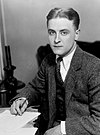The Diamond as Big as the Ritz
 Cover of the June 1922 issue of The Smart Set in which the story originally appeared. | |
| Author | F. Scott Fitzgerald |
|---|---|
| Country | United States |
| Language | English |
| Genre | Novella |
| Publisher | The Smart Set |
Publication date | June 1922 |
The Diamond as Big as the Ritz is a novella by novelist F. Scott Fitzgerald. It was first published in the June 1922 issue of The Smart Set magazine, and was included in Fitzgerald's 1922 short story collection Tales of the Jazz Age. Much of the story is set in Montana, a setting that may have been inspired by the summer that Fitzgerald spent near White Sulphur Springs, Montana in 1915.[1]
Plot summary[]
John T. Unger, a teenager from the Mississippi River town of Hades, is sent to a private boarding school near Boston. During the summer he visits the homes of his classmates, the majority of whom are from wealthy families.
In the middle of his sophomore year, a young man named Percy Washington is placed in Unger's dorm. He rarely speaks, and when he does, it is only to Unger. Percy invites Unger to his home for the summer, the location of which he only states as being "in the West." Unger accepts.
During the train ride Percy boasts that his father is "by far the richest man in the world", and boasts that his father "has a diamond bigger than the Ritz-Carlton Hotel."
Unger later learns that he is in Montana, in the "only five square miles of land in the country that's never been surveyed," and Percy's boasts turn out to be true.

Percy's ancestry traces back to both George Washington and Lord Baltimore. His grandfather, Fitz-Norman Culpepper Washington, decided to leave Virginia and head west with his slaves to enter the sheep and cattle ranching business. However, on his claim he discovered not only a diamond mine, but a mountain consisting of one solid diamond.
Washington immediately finds himself in a quandary; the value of diamonds multiplied by the sheer number available for him to mine would make him the richest man ever to live, but, based on the economic law of supply, the sheer number of diamonds, if ever discovered by outsiders, would drive their value to near zero, thus making him a pauper.
He immediately hatches a plan, whereby his brother reads to the African-American slaves a fabricated proclamation by General Nathan Bedford Forrest that the South had defeated the North in the American Civil War, thus keeping them in perpetual slavery. Washington travels the world selling only a few diamonds at a time, in order to avoid flooding the market, but enough to give him enormous wealth.
Apart from enslaving people, the Washington family goes to further appalling lengths in order to keep their diamond a secret. Airmen who stray into the area are shot down, captured, and kept in a dungeon. People who visit are killed and their parents told that they have succumbed to an illness while staying there.
John falls in love with Percy's sister, Kismine, who accidentally lets slip that John too will be killed before he is allowed to leave. That night, aeroplanes launch an attack on the property, having been informed by an escaped Italian language teacher. Percy's father offers a bribe to God, "the greatest diamond in the world", but God, being the Owner of everything, naturally refuses. John, Kismine, and Jasmine, another sister, escape while Percy and his mother and father choose to blow up the mountain rather than leave it in the hands of others. Penniless, the three survivors are left to ponder their fate.
Adaptations[]
Orson Welles adapted the story into a radio play in 1945 and another version was presented three times on the program Escape between 1947 and 1949.
A teleplay version was broadcast on Kraft Theatre in 1955. The story's sisters, Kismine and Jasmine, were portrayed by Lee Remick and Elizabeth Montgomery, who were unknowns of 20 and 22 at the time.
Mickey Mouse No. 47 (Apr./May 1956) contains a retelling of Fitzgerald's story under the title "The Mystery of Diamond Mountain", scripted by William F. Nolan and Charles Beaumont and illustrated by Paul Murry.
Jimmy Buffett recounts the story in the song "Diamond As Big As The Ritz" from his 1995 album Barometer Soup.
See also[]
Notes[]
- ^ Jones, Landon Y., "Babe in the Woods: F. Scott Fitzgerald's Unlikely Summer in Montana." Montana: The Magazine of Western History 57:3 (Autumn 2007): 34-45.
External links[]
| Wikisource has original text related to this article: |
- Streaming audio files
- The Diamond as Big as the Ritz on This Is My Best: April 3, 1945
- The Diamond as Big as the Ritz on Escape: July 21, 1947
- The Diamond as Big as the Ritz on Escape: August 29, 1948
- The Diamond as Big as the Ritz on Escape: March 27, 1949
- American novellas
- Novels by F. Scott Fitzgerald
- 1922 American novels
- Works originally published in The Smart Set
- Montana in fiction
- Fictional gemstones and jewelry
